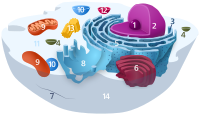
Photo from wikipedia
Toxicity mechanisms of metal oxide nanoparticles towards bacteria and underlying roles of membrane composition are still debated. Herein, the response of lipopolysaccharide-truncated Escherichia coli K12 mutants to TiO 2 nanoparticles… Click to show full abstract
Toxicity mechanisms of metal oxide nanoparticles towards bacteria and underlying roles of membrane composition are still debated. Herein, the response of lipopolysaccharide-truncated Escherichia coli K12 mutants to TiO 2 nanoparticles (TiO 2 NPs, exposure in dark) is addressed at the molecular, single cell, and population levels by transcriptomics, fluorescence assays, cell nanomechanics and electrohydrodynamics. We show that outer core-free lipopolysaccharides featuring intact inner core increase cell sensitivity to TiO 2 NPs. TiO 2 NPs operate as membrane strippers, which induce osmotic stress, inactivate cell osmoregulation and initiate lipid peroxidation, which ultimately leads to genesis of membrane vesicles. In itself, truncation of lipopolysaccharide inner core triggers membrane permeabilization/depolarization, lipid peroxidation and hypervesiculation. In turn, it favors the regulation of TiO 2 NP-mediated changes in cell Turgor stress and leads to efficient vesicle-facilitated release of damaged membrane components. Remarkably, vesicles further act as electrostatic baits for TiO 2 NPs, thereby mitigating TiO 2 NPs toxicity. Altogether, we highlight antagonistic lipopolysaccharide-dependent bacterial responses to nanoparticles and we show that the destabilized membrane can generate unexpected resistance phenotype. Pagnout et al investigate the multiscale response of deep rough Escherichia coli mutants to TiO 2 nanoparticle exposure and find that TiO 2 strips the cell membrane, which triggers osmotic and then oxidative stresses. Depending on their lipopolysaccharide surface-phenotype, the bacteria respond by releasing membrane vesicles that act as electrostatic baits for TiO 2 nanoparticles.
Journal Title: Communications Biology
Year Published: 2021
Link to full text (if available)
Share on Social Media: Sign Up to like & get
recommendations!